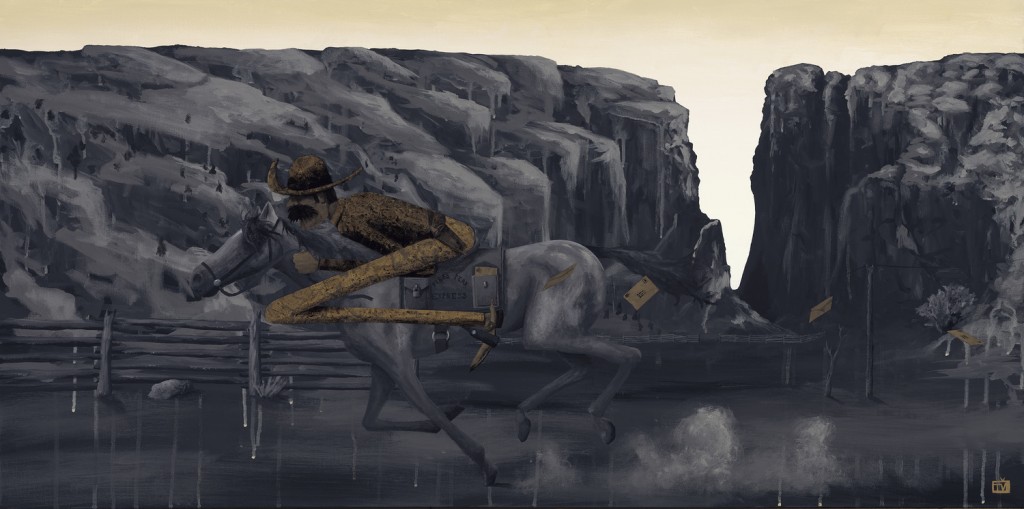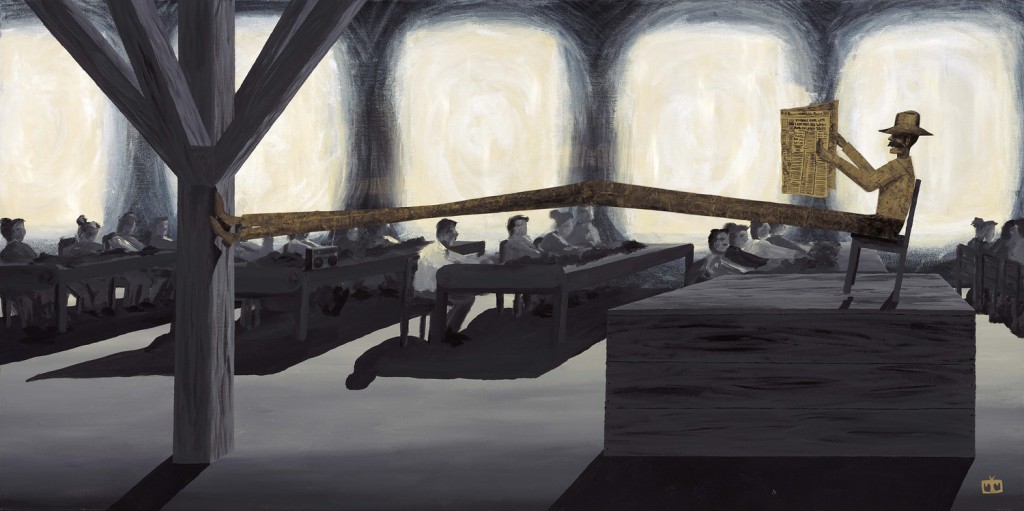Tyler Voorhees, 32, remembers plenty of tree forts and fishing poles during his childhood days on the flatlands of eastern South Dakota, which would help formulate his later creative development on his current collaging technique for his paintings. Today, he and his wife, Ashley and son, Ivan, live in Fort Collins, Colorado, where Voorhees now works full-time as an artist, after teaching second graders for several years. His art business is located in nearby Boulder.
The memories of his formative years in South Dakota have influenced a large-scale project called The Jobs of Yesteryear, which renders the history of occupations in unique paintings emphasizing the collage technique and underscoring a narrative specific to the occupation being portrayed. As he writes in his artistic statement, “The unique texture of each worker in the paintings is created using hundreds of hand-torn bits of kraft paper, which are collaged together and painted on before I adhere them to the wood panel. The workers are born from my own hands, a fitting tribute to the manual nature of work in years past.”

Voorhees, who has won numerous awards from various art festivals, is among the 167 artists being featured this year at the Utah Arts Festival. Recently, he graciously agreed to answer a few questions from The Utah Review about his creative process and his appearance at this year’s festival.
TUR: How have you used art media forms in helping to create an holistic body of artistic work that searches for a more complete expression of your own innermost and most powerful states of emotion, inspiration, contemplation and self-identity?
TV: For as long as I can remember, creating art has served as my means of expressing my view on the world. It’s a way to make sense of and catalogue all of the sensory input constantly streaming in through my eyes, ears and nose. After gathering all of this information on a daily basis, creating art is breathing it out. This has been true in everyday life and in the more extraordinary circumstances that life has brought me to. This act creates more room to grow and more room to examine the world around me.

TUR: What is your training as an artist? Who do you consider your most significant influences and inspirations? Do these influences shift as you progress both in your work and life?
TV: I have a bachelor’s degree in art, with a minor in biology. The late Richard Dubois and David Wilson were two incredible instructors that immensely shaped my practice. Dali was the first artist that opened my eyes to the wonders of surrealism and the seeds of his ideas continue to bear new fruit in my mind. There are numerous current artists that inspire and amaze me on a daily basis, with some of my favorites being Jenny Morgan, John Wentz and Basik. Influences are continually dancing around me as I experience more art and discover more about myself through creating it.
TUR: Do you work full-time exclusively as an artist? Or, how do you augment your work as an artist?
TV: I am a full-time artist.

TUR: Do you find it easy or difficult to start new work? And, typically, how do you prepare yourself to handle both the creative and physical demands of creating your art?
TV: Physical exertion through running, pushups or jumping rope helps clear my mind. I typically find it easy to start new work, but there are always the occasional tough days in the studio.
TUR: With regard to participating in the Utah Arts Festival, please share your feelings about being a part of this enterprise? Have you been in other festivals and do you plan to explore other festival venues?
TV: I don’t know much about Salt Lake City and the folks that live there, so I’m excited to broaden my horizons and see what it’s all about there. I exhibit at 15-20 art fairs around the country every year, along with occasional gallery exhibits.

